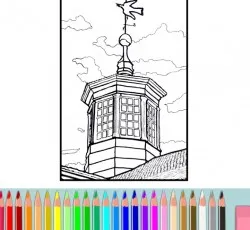Become an artist and color important moments in George Washington's life and aspects of daily life around Mount Vernon.

Washington in the Wilderness
At 21 years old, George Washington received his first commission in the British Army to travel to the territory beyond the Allegheny Mountains known as the Ohio Valley to demand French withdrawal from the western lands claimed by Virginia. After completing his mission, Washington faced a dangerous journey home, crossing the freezing Allegheny River in late December.
Color this Page
Map of the 13 Colonies
In 1775, George Washington was named Commander in Chief of the Continental Army by the Second Continental Congress. This Congress was made up of representatives from all 13 colonies and would declare American independence from Great Britain one year later. Washington remained Commander in Chief until the end of the Revolutionary War.
Color this Page
Washington Crossing the Delaware
As Commander in Chief of the Continental Army during the Revolutionary War, Washington led his troops across the icy Delaware River on Christmas night 1776, to attack Hessian troops in Trenton, New Jersey. The American army surprised the Hessian soldiers and won a much-need victory for George Washington.
Color this Page
George Washington at Princeton
This painting depicts Washington at the Battle of Princeton. This battle was fought on January 3, 1777 and marked the first time in open combat that American troops broke a British line. Washington himself rode at the head of his troops, in direct fire, seemingly invincible.
Color this Page
Washington Family Portrait
Artist Edward Savage painted a portrait of “The Washington Family” after he visited Mount Vernon. George Washington liked the painting a lot. He liked it so much he ordered a printed copy, to hang in his dining room. The portrait includes George Washington, his wife Martha Washington, two of his step-grandchildren, and an enslaved worker.
Color this Page
Spinning
Mount Vernon was essentially a self-contained community, nothing was purchased that could be produced on the estate. Most of the work done on the plantation was provided by slave labor. The spinning house was the most important structure on the north lane. At Mount Vernon, ten or more slaves were constantly employed spinning and knitting. The wool and flax fiber that they worked with were grown on site.
Color this Page
The Lower Garden
Seasonal fruits and vegetables were eaten fresh, making summer a bountiful time at Mount Vernon’s dinner table. In 1799 the day-to-day work was supervised by a hired Englishman named William Spence. He directed two enslaved gardeners, Harry and George. They were all tasked with bringing the food from seed to table.
Color this Page
The Cupola
Along with being nice to look at, the cupola tower was added to the Mount Vernon mansion for multiple reasons. It helped make the house look more symmetrical from the outside and created a draft to cool the house during the heat of the summer. Washington designed the weathervane to include the cardinal directions and the dove of peace.
Color this Page
The Gristmill
During the 1760s George Washington moved away from tobacco cultivation and began to plant more grains, primarily wheat and corn. With an expanded and more efficient gristmill, Washington could turn his crops into flour and cornmeal. His gristmill was capable of producing 5,000 to 8,000 pounds of flour and cornmeal a day.
Color this Page
Downloadable Coloring Pages
Looking for more options? Click each link to access downloadable coloring pages!
George Washington at Princeton
Interactive Tools
Click the link to return to the Interactive Tools page
Mount Vernon Interactive Tools